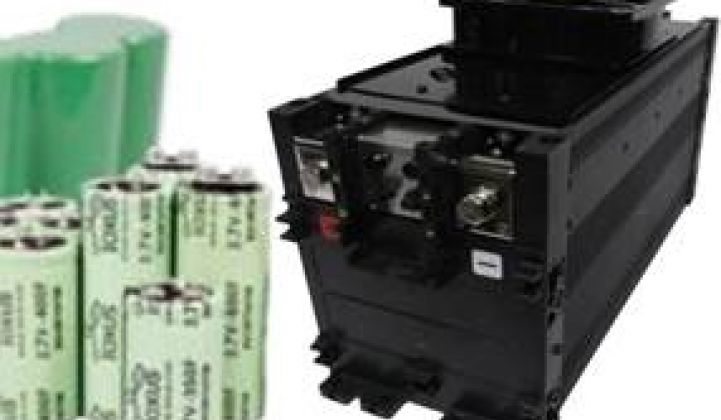Ultracapacitors discharge faster than rechargeable batteries and supply momentary power quickly. They recharge faster and degrade little from multiple charge/discharge cycles -- but don’t hold as long-lasting an energy supply.
In energy storage jargon, ultracaps may have as little as one-tenth the energy density but as much as ten to 100 times the power density. Ultracap manufacturer Ioxus says its new cells change that.
Their prismatic (i.e., flat) shape allows the Ioxus cells to be stacked in modules. “In a six-pack of beer, you have space between each of those cylinders. That is wasted space,” explained Ioxus founder and Vice President of Sales Chad Hall of the difference between conventional cylindrical ultracapacitor modules and their product. It's “17 percent more efficient to use a prismatic cell.”
“It is like a stack of playing cards in a vacuum-sealed bag instead of a round can with heavy terminals and wasted space,” Hall said. He added that cylindrical ultracaps from other vendors like Maxwell Technologies take up more volume, are heavier, and have less energy and power density.
The Ioxus cells will add perhaps 50 percent to Ioxus' 2012 sales, Hall said. “We already have customers and others testing them and planning to buy them.” Hall could not, however, provide specific numbers. “We never disclose our revenues publicly. I can tell you from 2011 to 2012, we’ve gone up [by a factor of] seven,” he said, adding, “I think in the next year, from 2012 to 2013, we will again be in the seven-times-growth range.”
Maxwell Technologies is the established player in the ultracapacitor space. Of its $157 million in 2011 sales, $97 million came from ultracaps, according to the company's Communications Vice President Michael Sund. Maxwell makes cylindrical ultracaps, Sund said, though it does have one prismatic product. “Maxwell has made prismatic products in the past and evolved to the current type of construction for reasons of cost and manufacturability. It is possible we would manufacture prismatic products in the future.”
The Ioxus prismatic ultracaps, Hall said, are possible because of a patented venting technology for gases that would otherwise build up in the pouch which encases the cells. Ioxus acquired the patent through its February purchase of Power Systems Limited. “The one-way vent allows the gas to escape so the pouch does not expand,” Hall explained. “It is like balloon with a small hole in it. You can keep blowing it up, but it is never going to pop.”
According to Hall, no other ultracap maker has the venting technology. “We know it works because Power Systems Limited has millions of installed hours,” Hall said. “They have been reliably installed in a variety of products, including cranes, photocopiers and voltage sag compensation systems up to four megawatts.”
“There are applications for cylindrical modules,” Hall acknowledged, “like hybrid diesel-electric buses.”
“The largest consumer of our ultracapacitor,” Maxwell’s Sund said, “is hybrid electric transit bus drive systems where the ultracapacitors capture braking energy.” Fuel consumption and tailpipe emissions are reduced, Sund said, because “hybrid buses take off all-electric with the stored electrical energy generated during braking.”
“But for high-energy in rack mount applications, or very-small-space applications, Ioxus [products] make more sense,” said Hall, who claimed a 79 percent to 101 percent improvement in watt-hours for Maxwell's cylindrical ultracaps in typical rack-mount configurations.
Rack-mount applications include uninterruptible power supply (UPS) systems used during blackouts to bridge the gap between the grid electricity supply and backup generating systems in critical settings like hospitals and data and communications centers.
Rack-mounted ultracaps can also protect factory operations from voltage drops. In a silicon manufacturing plant, Hall noted, “If they have a change in power when they are slicing a silicon ingot, that piece of silicon becomes garbage. The machine stops and they have to reset and move everything. It can cost hundreds of thousands of dollars in one hour.”
Ultracaps also supply short bursts of power to alter wind turbine blade pitch during sudden wind speed changes. Peak power-shaving systems, automated guided vehicles, and large cranes are also important applications.
Both Hall and Sund said automotive applications are an important emerging opportunity.
“I don’t think we will ever beat lithium-ion batteries,” Hall said, “but we can make them last longer.” Ultracaps can, he said, capture current during deceleration and braking and deliver it for acceleration or to hold up some of the electronics during a start-stop. But, he added, only Maxwell is now in the automotive market.
Maxwell ultracaps, Sund said, are part of the internal combustion engine stop-start idle elimination system made by German auto parts supplier Continental AG for French automaker PSA’s Peugeot and Citroen brands. “It turns off the engine when it would otherwise be idling and then seamlessly restarts it when the driver releases the brake pedal.”
Toyota hybrids now use Panasonic ultracaps, Sund said, and a 2013 Mazda entry will use Nippon Chemicon.
“Automotive is a high-volume opportunity for ultracapacitors,” Sund said. “I am sure that all manufacturers are eyeing it eagerly.” The market, he added, is “huge and emerging. There is room for all types of players and products.”



